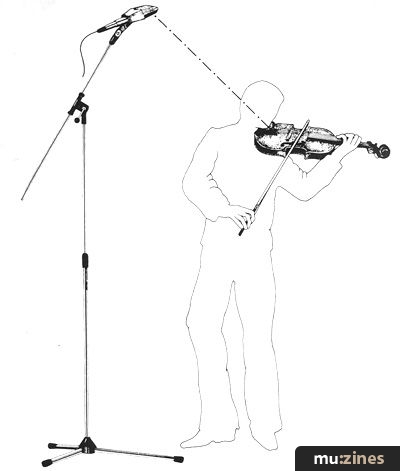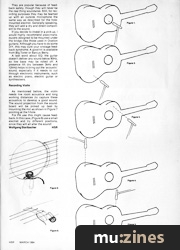Magazine Archive
Home -> Magazines -> Issues -> Articles in this issue -> View
Using Microphones | |
Miking Up Acoustic String InstrumentsArticle from Home & Studio Recording, March 1984 | |

Figure 7
Miking up an acoustic guitar or a violin illustrates wonderfully the basics of microphone placement. Here's how to approach the problem:
- Understand how the instrument works, ie. generates sound and how it projects that sound (radiation pattern).
- Determine the relationship between instrument and room acoustics (which 'shape' the sound in a concert situation and therefore are part of the instrument's sound as we hear it).
- Experiment with microphone placement until it satisfies your own ears and taste.
Acoustic Principle
The strings are strummed or bowed and thus set in motion. The string's vibration is transmitted by the bridge onto the soundboard. The soundboard is carefully tuned with regard to its resonant frequencies by altering the pattern and thickness of the bracing inside, but resonances also depend on the shape, material and laquer of the soundboard. These resonances, together with the ones from the sound-hole and the entire instrument body amplify the sound.
Sound Radiation
The sounds produced by the different vibrating parts of a string instrument are of different tonal qualities: the soundhole radiates a bassy sound, the strings' direct radiation is rather bright. The main sound radiating part is the soundboard. Its bracing pattern causes different resonances in different places, so here again sound radiation is not uniform throughout, which is important to understand when selecting microphone positions.
Instruments generally radiate different sounds from their various parts, and the radiation pattern changes with frequency.
At some distance from the instrument these different sound qualities blend together to form a satisfying sound. This effect can be compared to a multiple speaker system, which will deliver its full sound only at a certain distance. Miked up close, the nearest speaker's output will be over-emphasised.
Room Acoustics
Bowed string instruments, particularly the violin, need good room acoustics for a good sound. Research into the violin's sound behaviour (with six microphones placed around the violin) showed that what is projected in any one particular direction, as picked up by one close microphone, will sound poor. But in a 'live' environment the first reflections from walls, ceiling and floor (see HSR Jan. 84) contribute that part of the sound that does not reach the listener or the microphone directly. This is why the violin sounds best in a good concert hall.
Recording Acoustic Guitar

Figures 1 - 5
For PA reinforcement applications, the guitar is always miked up very close, with the microphone pointing to the soundhole. (See Figure 1).
Here the guitar sounds loudest, which is usually most important because of feedback risks, but the sound is a little bassy and muddy.
A better result will be obtained by recording off the soundboard. As the acoustic guitar is a rather quiet instrument, working distance should not be too great, 15" is OK.
The two set-ups shown in Figures 2 & 3 are most commonly used in studios. Alternatively the guitar may be miked up from above, same working distance, with the microphone pointing to the bridge or the soundhole. (Figures 4 & 5).
The microphones you may use include condensers, with large diaphragm models (AKG C414, Neumann U47) offering a warmer sound as compared to the bright sound of small diaphragm types (AKG CK1)/C451, Shure SM81 for example).
In case of sound leakage problems, or for a different sound, high-quality dynamic microphones are sometimes used: AKG D224, Sennheiser MD 441 etc. It's also quite common to mike up the guitar from inside the soundhole, using small electret types (AKG C567, Sony ECM-50, a Countryman or the like). See Figure 6.

Figure 6
For recording purposes, however, the sound of this microphone should be combined with that of an outside mic, which will pick up the bass and high treble a lot better.
Pick-Ups
There are two basic types of guitar pick-ups: magnet types, which only work with metal strings; and piezo types, which are mounted to the body, sensing its vibrations.
They are popular because of feedback safety, though they will never be the real thing soundwise. Still, for recording purposes they may be teamed up with an outside microphone the same way as described for the hole-mounted electret. Generally speaking, they will add a dry and direct component to the sound.
If you decide to invest in a pick-up, I would highly recommend piezo-transducers designed to be mounted under the bridge (like those used in Ovation guitars). Although you have to do some DIY, this may cure your onstage feedback syndrome. A good kit is available from Big Toner or Barcus Berry.
A last word about EQ: the guitar doesn't deliver any sound below 90Hz, so low bass may be rolled off. A presence lift (try between 3kHz and 12kHz) helps to bring out the 'acoustic' sound, especially if it needs to cut through electronic instruments, such as electric piano, electric guitar or synthesisers.
Recording Violin
As mentioned before, the violin needs live room acoustics and long working distances (to capture these acoustics) to develop a good sound. The sound projection from the soundboard will be picked up best by mounting the mic as shown in Figure 7 pointing at the f-hole.

Figure 8
For PA use this might cause feedback. In this case, (Figure 8) use a small electret and try different positions, since they will all alter the sound!
More from these topics
Willow - The Recording of a Film Soundtrack Music |
Before You Start Making That Demo Tape - Demo Tape Discipline |
Step by Step |
Hands On: Cassette Multitracks |
Home Recording - The Four Track Future - Where To Start With Cassette-Based Recording |
State Of Independence - Dave Stewart On Going It Alone In The Music Biz |
Rhythm methods - Drum recording guide |
Miking Music |
When the Pressure's On |
Basic Multitrack (Part 1) |
Sound Advice (Part 1) |
The Jump To 8-Track |
Browse by Topic:
Microphones
Recording
Publisher: Home & Studio Recording - Music Maker Publications (UK), Future Publishing.
The current copyright owner/s of this content may differ from the originally published copyright notice.
More details on copyright ownership...
Feature by Wolfgang Staribacher
Help Support The Things You Love
mu:zines is the result of thousands of hours of effort, and will require many thousands more going forward to reach our goals of getting all this content online.
If you value this resource, you can support this project - it really helps!
Donations for April 2024
Issues donated this month: 0
New issues that have been donated or scanned for us this month.
Funds donated this month: £7.00
All donations and support are gratefully appreciated - thank you.
Magazines Needed - Can You Help?
Do you have any of these magazine issues?
If so, and you can donate, lend or scan them to help complete our archive, please get in touch via the Contribute page - thanks!
















